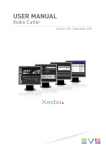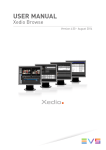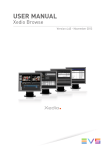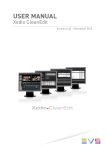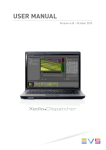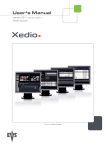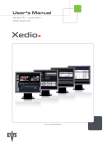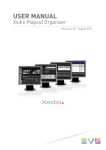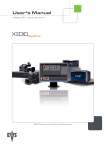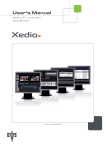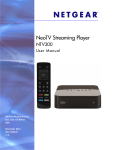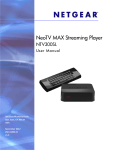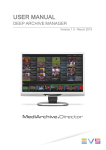Download Xedio Cutter User Manual
Transcript
USER MANUAL Xedio Cutter Version 4.35 - August 2013 USER MANUAL Xedio 4.35 Xedio Cutter Copyright EVS Broadcast Equipment SA– Copyright © 2010-2013. All rights reserved. Disclaimer The information in this manual is furnished for informational use only and subject to change without notice. While every effort has been made to ensure that the information contained in this user manual is accurate, up-to-date and reliable, EVS Broadcast Equipment cannot be held responsible for inaccuracies or errors that may appear in this publication. Improvement Requests Your comments will help us improve the quality of the user documentation. Do not hesitate to send improvement requests, or report any error or inaccuracy on this user manual by e-mail to [email protected]. Regional Contacts The address and phone number of the EVS headquarters are usually mentioned in the Help > About menu in the user interface. You will find the full list of addresses and phone numbers of local offices either at the end of this user manual (for manuals on hardware products) or at the following page on the EVS website: http://www.evs.com/contacts. User Manuals on EVS Website The latest version of the user manual, if any, and other user manuals on EVS products can be found on the EVS download center, on the following webpage: http://www.evs.com/downloadcenter. I USER MANUAL Xedio 4.35 Xedio Cutter Table of Contents TABLE OF CONTENTS III WHAT'S NEW? V 1. 1 INTRODUCTION 1.1. Product Description 1 1.2. Opening Xedio Cutter 1 1.3. Overview of the Xedio Cutter Window 2 1.4. Process Overview 3 2. 4 MEDIA MANAGER 2.1. Purpose 4 2.2. Overview of the Media Manager 4 2.3. Elements Grid 5 2.3.1. Sorting the Elements in the Grid 5 2.3.2. Organizing Columns 5 2.3.3. Element Contextual Menu 6 2.4. Searching for Elements in the List 6 2.4.1. Introduction 6 2.4.2. Quick Text Search 7 2.4.3. Advanced Search 9 2.4.4. Using Saved Filters 3. PLAYER 17 3.1. Purpose 17 3.2. Overview of the Player Pane 17 3.3. Video Display Options 19 3.4. Player Functions 19 3.4.1. Player Transport Controls 19 3.4.2. Media Bar and Jog Bar 21 3.4.3. Clip Creation Functions 24 3.4.4. Timecode Information 24 3.4.5. Video and Audio Monitoring Tools 24 3.4.6. Logs 27 3.5. Loading Media on the Player Window 28 3.6. Making a Clip 28 4. STORYBOARD 4.1. Purpose Table of Contents 15 30 30 III EVS Broadcast Equipment SA IV Issue 4.35.B - August 2013 4.2. Creating and Managing the Storyboard List 30 4.3. Previewing the List 32 4.4. Exporting the Storyboard 32 4.4.1. Introduction 32 4.4.2. Exporting the Storyboard to Edit 33 4.4.3. Exporting the Storyboard to a Playlist 34 4.4.4. Exporting the Storyboard as a File 34 4.4.5. Exporting the Storyboard to a Target 35 Table of Contents USER MANUAL Xedio 4.35 Xedio Cutter What's New? In the user manual, the icon has been added on the left margin to highlight information on new and updated features. The sections updated to reflect the new and modified features in Xedio Cutter from Xedio Suite 4.03 and 4.35 (compared to Xedio Suite 4.02) are listed below. New behavior for the J, L shortcuts • The first time the J or the L shortcut is pressed, the speed is 100%. See section "Player Transport Controls" on page 19. Export to an XSquare target • XSquare can now be used with the Xedio Suite. A storyboard can be exported to a predefined XSquare target. See section "Exporting the Storyboard" on page 32. • The export can be monitored. See section "Monitoring the Export Process to a Target" on page 36. Audio mono tracks can be used in the Xedio Suite See section "Video and Audio Monitoring Tools" on page 24. See section "Audio Management for the Exported Edit" on page 33. What's New? V USER MANUAL Xedio 4.35 Xedio Cutter 1. Introduction 1.1. Product Description The Xedio Cutter is a module of the Xedio Suite of applications. It allows the selection of portions of media to be placed into a list to export (the storyboard) as a “rough cut edit”. This can then be refined and produced as a final edit using the more sophisticated tools available in the full non-linear timeline editing environment it provides. 1.2. Opening Xedio Cutter To start the Xedio Cutter application, click on the Xedio Cutter icon on the desktop. This will display a login screen where you need to enter your username and password. 1. Introduction 1 EVS Broadcast Equipment SA 1.3. Issue 4.35.B - August 2013 Overview of the Xedio Cutter Window Illustration The window contains the areas highlighted on the screenshot below: Note The color of some user interface elements may vary with the Xedio skin installed. 2 1. Introduction USER MANUAL Xedio 4.35 Xedio Cutter Area Description The table below describes the various parts of the window: 1.4. Part Name Description 1. Player Pane This is used to load and play media, to make clips and create the elements to place into the storyboard area. All types of media and clips can be played back but clips can only be made from video assets. Everything that is outside the video content has the skin color. Video such as letterboxed or pillarboxed video will show black bars as these mattes are part of the video signal When the Preview button is clicked, the Player window is replaced by the Storyboard Preview window. 2. Media Manager This is used to select the media to view in the Player window. It has the same powerful filtering and search attributes as other parts of the Xedio Suite of applications: this makes finding the required material an easy process. 3. Storyboard When clips are ready to export, they are added to the Storyboard area using the drag-and-drop technique. The order in which the clips appear in the list will be the order they are placed when exported. Process Overview The use of Xedio Cutter can be summarized as follows: 1. Select a media from the Media Manager See section "Media Manager" on page 4. 2. Load it on the Player Pane See section "Loading Media on the Player Window" on page 28. 3. Make a new clip See section "Making a Clip" on page 28. 4. Send the clip to the Storyboard See section "Creating and Managing the Storyboard List" on page 30. 5. Preview the Storyboard in the Player Pane See section "Previewing the List" on page 32. 6. Export the Storyboard See section "Exporting the Storyboard" on page 32. 1. Introduction 3 EVS Broadcast Equipment SA 2. Media Manager 2.1. Purpose Issue 4.35.B - August 2013 The Media Manager pane allows you to quickly find and browse the available A/V media present within the database. 2.2. Overview of the Media Manager The upper part of the pane gives access to the different filters which can be applied to the media list. At least two tabs exist on the left of the Media Manager window. • The Filter 0 tab: The element list displays the list of all media present in the database, or it returns the result of a search applied to the list. • The Today tab: the element list shown the media with "creation date = today". Additional tabs are displayed when the users have saved filters applied to the database. " for more details. Media items are displayed in columns. The element list displays the list of all media present in the database, or it returns the result of a search applied to the list. 4 2. Media Manager USER MANUAL Xedio 4.35 Xedio Cutter 2.3. Elements Grid 2.3.1. Sorting the Elements in the Grid You can change the sort order of elements in the grid by clicking the column header for the parameter according to which you want to sort the elements. The blue arrow indicates the sorting order. Clicking the column header again changes the sorting order from ascending to descending or vice versa. 2.3.2. Organizing Columns Resizing Columns A column can be resized by using the mouse pointer over columns intersection and dragging it to the right or to the left. Selecting Columns to Display To select the columns to display in the grid, proceed as follows: 1. Right-click the column header area. A menu is displayed. 2. Select Choose Displayed Columns. The Select Visible Columns window opens and shows the list of columns in the current order. 3. To select the column(s) you wish to add to the view, do one of the following: ◦ in the left pane, double-click the column(s) you wish to add to the view ◦ select them in the left pane and click the Add button 4. To select the column(s) you wish to remove from the view, do one of the following: ◦ on the right pane, double-click the column(s) you wish to remove from the view ◦ select them on the right pane and click the left arrow 5. Click OK. Ordering Columns To change the columns order, proceed in one of the following ways: 1. Select a column header 2. Drag it to the left or right to the required place. A vertical line shows the place where the column will be dropped. OR 2. Media Manager 5 EVS Broadcast Equipment SA Issue 4.35.B - August 2013 1. Right-click a column header. A menu is displayed. 2. Select Choose Displayed Columns. The Select Visible Columns window opens and shows the list of columns in the current order. 3. Select the column name(s) from the Selected pane. 4. Click the appropriate button: ◦ Up: moves the item(s) before the previous one ◦ Down: moves the item(s) after the next one 5. Click OK. 2.3.3. Element Contextual Menu A contextual menu with the following options is available when you right-click an item in the list. Play Loads the media in the Player to allow the element to be browsed and modified. Render List Opens the Render List window listing all types of rendering that have been done with the media. Archive History Opens the Archive History window listing the archive and restore processes that were achieved for the selected media. View Properties Opens the Media Properties window which shows the properties for the selected media. If a default metadata profile has been defined for the media, a metadata tab is displayed and shows the media metadata. See the Xedio Manager manual for more information on the selection of a profile. 2.4. Searching for Elements in the List 2.4.1. Introduction When the database contains large amounts of data, it may become difficult to find a specific element. The Media Manager offers several ways to speed up your search: 6 • quick text search • filters on parameters 2. Media Manager USER MANUAL Xedio 4.35 Xedio Cutter By default, the columns that are taken into consideration for the Quick Text Search are the ones currently visible in the grid. If you wish to search in other columns, and view the string you are searching for in the columns, you can: • add other columns to the Elements grid view • use Filters, as explained in section "Advanced Search" on page 9. These search tools are explained in detail below. An applied filter can be saved for later use. Such a saved filter can then be applied in one click. A search can also be facilitated by ordering the Elements grid. 2.4.2. Quick Text Search Purpose and Context of Use The Quick Text Search function is used to perform a search based on free text entered in the Quick Text Search field. This field is available on the top of the Elements grid. It allows searching for a string in the displayed columns. Users can enter a search string in one of the following ways. • They enter the search string in full in the Quick Text Search field. The Quick Text Search option obeys specific rules which can be accessed via the Help button next to the Quick Text Search field. See section "Quick Text Search Rules" on page 7 for more details on these rules. • They click the arrow next to the Quick Text Search field, so the last 10 searches are displayed, and they select one of them. Quick Text Search Rules The string that you enter in the Quick Text Search field is analyzed according to the following set of rules, which can be accessed via the Help button Text Search field. next to the Quick The free text search is not a case sensitive operation. 2. Media Manager 7 EVS Broadcast Equipment SA Issue 4.35.B - August 2013 Search String Search Result Yellow card Searches for the strings "yellow" and "card", even if in two different fields (columns), for example "yellow" in Name and "card" in Keywords. For example a clip named "The Yellow Man" with keywords "Red Card" will be found, since it has yellow and card in 2 different fields. "Yellow card" Searches for strings containing "Yellow card". Yellow | card Searches for "yellow" or "card", even if in two different fields (columns), for example "yellow" in Name or "card" in Keywords. Spaces around the | sign are mandatory. yell* Searches for "yell" at the beginning of a string. *low Searches for "low" at the end of a string. Ye*low Searches for strings with "ye" at the beginning and "low" at the end. Ye*low 123 Searches for strings with "ye" at the beginning and "low" at the end and which contains "123". =card Searches for a string exactly equals to "card". For example, if a field contains "yellow card", the =card condition will not return any result. =”yellow card” Searches for a string exactly equals to "yellow card". The use of quotes is required due to the space between "yellow" and "card". How to Perform a Quick Text Search To perform a Quick Text search, proceed as follows: 1. Display the columns you wish to perform a quick search on. 2. Type a search string in the Quick Text Search field, based on Quick Text search rules available from the Help button Rules" on page 7. and detailed in section "Quick Text Search 3. Click the Search button to apply the Quick Text Search. Depending on whether the AutoRefresh Filtering setting is selected or not, you may not have to click the Search button to apply the Quick Text Search. Refer to the tab Software > Parameter Profiles > General > General in Xedio Manager. The search result is displayed in the grid. 4. To clear the applied Quick Text Search, click the red button to the right of the search field or select <empty> from the Quick Text Search drop-down list. 8 2. Media Manager USER MANUAL Xedio 4.35 Xedio Cutter 2.4.3. Advanced Search Purpose and Context of Use The Advanced Search functions are available for more detailed search operations. They allow searches on media metadata. From the Today tab, the filter "creation date = today" is automatically applied. The Advanced Search fields can be displayed on the top left part of the Elements grid. Advanced Search Fields Display Displaying Advanced Search Fields Show/Hide Filter Button To display the Advanced Search fields, click the Show/Hide Filter button grid. above the The Advanced Search area is expanded as follows: The Show/Hide Filter button can be displayed with two different colors: Button Display (gray) (colored) Meaning The Show/Hide Filter button is gray when all filter criteria are hidden. Consequently, the filters are inactive. The Show/Hide Filter button is colored when the Advanced Search area is visible, even if no filtering criterion is applied. Criteria Combination Field The first field under the Show/Hide Filter button lists three options for the combination of criteria to be taken into account during the filtering operation. 2. Media Manager 9 EVS Broadcast Equipment SA Issue 4.35.B - August 2013 Option Meaning ALL criteria are met All the criteria selected in the Filter fields displayed under the Criteria Combination field must be met. The media displayed in the Elements grid fulfill all the selected filter criteria. ANY criteria is met At least one of the criteria selected in the Filter fields must be met. The media displayed in the Elements grid fulfill at least one of the selected filter criteria. NO criteria is met None of the criteria selected in the Filter fields displayed under the Criteria Combination field must be met. The media displayed in the Elements grid fulfill none of the selected filter criteria. Search Parameters List The second field gives access to the list of available advanced search parameters. Click the arrow next to the field to display the list. Users are then able to add as many search fields as needed and to enter search criteria for each of them. Advanced Search Fields Once a search parameter has been selected, an entire line is displayed. Interface Element Description 1 Selected search parameter. 2 Various fields used to enter the filter criteria. See section "Advanced Search Fields Types" on page 11. Used to remove the corresponding filter line. Used to add a new filter line. Hiding Advanced Search Fields To hide all the Advanced Search fields, click the Show/Hide Filter button again. Consequently, all the applied filters are removed. To remove an Advanced Search field from the Advanced Search area and thus clear the corresponding applied filter, click the 10 button next to the field. 2. Media Manager USER MANUAL Xedio 4.35 Xedio Cutter Advanced Search Fields Types Depending on the selected search parameter, different types of advanced search fields will be displayed and available to enter criteria. Timecode or Duration Parameter Such as TC IN, TC OUT, Duration… 1. Select a logical operator in the first field 2. Enter a timecode or duration value in the second field. Timecode Range 1. Select an option from the first field 2. Enter a timecode value. This will include, or exclude, media containing the specified timecode value. Date Such as Creation Date Several Date Search filters exist. 1. Select a condition or a logical operator in the first field 2. Media Manager 11 EVS Broadcast Equipment SA Issue 4.35.B - August 2013 2. This will condition the next step: ◦ Search based on a specific date (e.g. with =…): a calendar will be displayed for the selection of a date. ◦ Search based on an interval (e.g. with […] (between)…): two calendars are displayed for the selection of two dates. ◦ Search based on a specific date calculated from the current date (e.g. with tomorrow, last month,…): no other field appears. Time Such as Last Rendered Date Time Several Date Search filters exist. 1. Select a condition or a logical operator in the first field 12 2. Media Manager USER MANUAL Xedio 4.35 Xedio Cutter 2. This will condition the next step: ◦ Search based on a specific date and time (e.g. with =…): two additional fields will be displayed, a calendar for the selection of a date and drop-down list for the selection of time. ◦ Search based on a specific date and time calculated from the current date and time (e.g. with next hour, last month,…): no other field appears. Number Such as DB Id 1. Select a logical operator in the first field 2. Enter a number in the second field. Note <> means "differs from". Option List Such as Video Standard 1. Select a logical operator in the first field 2. Click the parameter. button to display the list of options available for the selected filter Example for the Video Standard: 3. Select an option from the list. 2. Media Manager 13 EVS Broadcast Equipment SA Issue 4.35.B - August 2013 Boolean Such as Published • Select Yes or No from the single criteria field. Free Text Such as Label 1. Select a condition in the first field. 2. Enter free text in the second field. How to Perform an Advanced Search To enter search values in the Advanced Search fields, proceed as follows: 1. Choose the columns you wish to perform a search on. 2. Click the Show/Hide Filter button The Advanced Search area is displayed: 3. Select a criteria combination from the list: 4. Select a search parameter from the list of parameters. An entire line, corresponding to the selected filter parameter, is displayed: 14 2. Media Manager USER MANUAL Xedio 4.35 Xedio Cutter 5. Enter filter criteria as explained in section "Advanced Search Fields Types" on page 11. For free text fields, press ENTER to apply the filter. Otherwise, the Elements grid is automatically filtered and refreshed. 6. If required, click the 2.4.4. button to add another advanced search parameter. Using Saved Filters Introduction Once you have defined filters and search terms, you may want to save them for later use. You will then be able to apply the same set of filters with a single click. Saved filters appear as tabs. At least two tabs exist on the left of the Elements grid. • The Filter 0 tab: The Elements grid displays the list of all elements present in Xedio Dispatcher, or it returns the result of a search applied to the list. • The Today tab: the Elements grid shows the elements with "creation date = today". Warning Those filters can be modified by the user, so the results could no longer reflect the tab label. Saved Filter Contextual Menu Right-clicking in the Filter 0 tab displays a contextual menu with the following options: Create New Filter Allows to create a new filter tab through the Filter Edit Dialog wndow: Save Filter As Allows to create a new filter tab in which the current search filter will be saved. Filter Properties Allows to change the name and/or description of the selected filter tab. Reset Filter Removes all search criteria on the selected filter tab. Delete Filter Removes the filter tab. 2. Media Manager 15 EVS Broadcast Equipment SA Issue 4.35.B - August 2013 How to Save Filters To save filters, proceed as follows: 1. Define the filter or filters combination you wish to save, as explained in section "How to Perform an Advanced Search" on page 14. 2. Right-click the Filter 0 tab. 3. Select Save Filter As from the contextual menu. The Filter Edit Dialog box opens. 4. Enter a label for the tab you are going to create and, if required, enter a description. 5. Click OK. The new filter tab is displayed on the left of the list. How to Apply a Saved Filter To apply a saved filter, simply click the corresponding tab. 16 2. Media Manager USER MANUAL Xedio 4.35 Xedio Cutter 3. Player 3.1. Purpose The Player is used to load and play media from the Media Manager area, to make clips and create the elements to be placed in the Storyboard area. 3.2. Overview of the Player Pane The Player pane provides a video display, a media bar and a jog bar to navigate within the element, video and audio selection and monitoring buttons, transport buttons and timecode fields, audio vumeters. The following table briefly describes the various zones on the Player area and refers to the section where the fields are detailed. 3. Player 17 EVS Broadcast Equipment SA Issue 4.35.B - August 2013 Part Name Description 1. Video Display It displays the video material loaded on the Player. Everything that is outside the video content has the skin color. Letterboxed or pillarboxed video show black bars as these mattes are part of the video signal. Parameters related to the display are available via a contextual menu. See section "Video Display Options" on page 19. 2. Track Selection Buttons They allow the user to select the tracks to be taken into account for the loaded material. See section "Video and Audio Monitoring Tools" on page 24. 3. Jog and Media Bar They allow the user to navigate in the loaded material, to place IN, OUT and nowline points, as well as to modify the playback speed of the material. See section "Media Bar and Jog Bar" on page 21. 4. Clip Creation They are used to create new clips, and get the exact timecode of Fields the nowline, IN and OUT points. See sections "Clip Creation Functions" on page 24 and "Timecode Information" on page 24. 5. Cue Point Icons The cue points make it possible to add reference points to easily identify positions of interest in the loaded media. See section "Logs" on page 27. 6. Transport Control Icons They are used to play back the loaded media. See section "Player Transport Controls" on page 19. 7. Server Recorder Selection The button acts as a toggle switch between the Track Selection buttons the camera selection list and Several cases can occur: • If a record train of an EVS Video Server is loaded, this allows the user to load another record train on the given server. • If a clip belonging to a group of linked clips is loaded (for example, clips created with ganged channels in IPDirector), the list displays the various camera angles and allows the user to select a clip linked to the one loaded. • If an individual clip is loaded, only its recorder channel is available. If a media ingested from an encoder is loaded, the not available. 8. 18 Audiometers button is Audio meters represent the audio channels of the monitored track. 3. Player USER MANUAL Xedio 4.35 Xedio Cutter 3.3. Video Display Options A contextual menu is available when right-clicking the Video Display area. This gives display options for the video. Option Meaning Show Timecode This option offers various options to display timecode on the Player window. • none: does not display timecode. • Start TC: shows a counter starting with 0 at the first frame of the media. • Intra TC: shows the original timecode of the media. Up to two TC options can be selected. Aspect Ratio This option offers a choice of aspect ratios for the display: Auto, 4:3 or 16:9. Show SafeAreas This option displays a safe area cage on the window to determine which areas of the picture will be seen. This allows to check the size of graphics within the media for safe display. Grab Image Grabs the current image, either in low resolution or in high resolution. The default folder (c:\) where the grab is stored is defined in Xedio Manager > Software > ParameterProfiles > General Settings: GrabStillFrameFolder parameter. Show Label Displays the name of the loaded item on the top of the Video Display. 3.4. Player Functions 3.4.1. Player Transport Controls The following table shows an overview of the various transport control commands in the Player. A button and/or a keyboard shortcut can be used to perform each action. For a full list of commands activated via a shortcut key, refer to Xedio Manager: Softwares > Keyboard Profiles > Xedio Cutter > default > Player. Note The user can customize the keyboard shortcuts in Xedio Manager to perform transport control commands. The keys mentioned below are the default settings. 3. Player 19 EVS Broadcast Equipment SA Operation Issue 4.35.B - August 2013 User Interface Button Play and Stop ↔ Play when recorded + Play from IN to OUT ↔ Loop + Goto IN Goto OUT Button used to play from the marked IN point to the OUT point. This loops the playout from IN to OUT. This moves the current nowline position to the already existing IN point. + This moves the current nowline position to the already existing OUT point. + Goto Next Frame This is used together to move 10 frames backward. Button used to move from the current position to the following frame. Go 10 frames forward + This is used together to move 10 frames forward. Button used to start moving backwards through the media at a preset fast speed. The speeds are set in the Database Manager application. ↔ Increase Rewind Speed Increase Forward Speed This starts the playout at the end of a media currently being recorded. Button used to move from the current position to the previous frame. Go 10 frames backward Fast Forward Button used to start/stop the preview (video and/or audio) of the loaded media. + Goto Previous Frame Fast Rewind Description + This increases the fast rewind speed. Button used to start moving forwards through the media at a preset fast speed. The speeds are set in the Database Manager application. ↔ + This increases the fast forward speed. The , and keyboard shortcuts are used to navigate (in a combination of shuttle and scrub at the same time) backwards and forwards in A/V content. The following table lists their different uses. 20 3. Player USER MANUAL Xedio 4.35 Xedio Cutter Keyboard Shortcut Function Description Shuttles/scrubs backward at twice the real time speed. Pressing repeatedly the key will increase the shuttling/scrubbing speed in a loop: x1, x2, x3, x5, x8 and then back to x1. Note If another key is pressed between the repetitions, the shuttle/scrub speed is reset. Stops the preview of the A/V content. Shuttles/scrubs backward at twice the real time speed. Pressing repeatedly the key will increase the shuttling/scrubbing speed in a loop: x1, x2, x3, x5, x8 and then back to x1. Note If another key is pressed between the repetitions, the shuttle/scrub speed is reset. 3.4.2. Hold + tap Hold + tap Hold + hold Hold + hold Steps backward 1 frame at a time. Steps forward 1 frame at a time. Plays backward at 33% of the real time speed. Plays forward at 33% of the real time speed. Media Bar and Jog Bar Media Bars Top Bar The top bar represents the media, or a portion of it, currently loaded on the Player. The mark IN, mark OUT and nowline are displayed on this top area. 3. Player 21 EVS Broadcast Equipment SA Issue 4.35.B - August 2013 Middle Bar The middle bar is used to zoom into the loaded element. Its dark gray zone shows the section of the media, out of the whole media, visible in the top bar and the relative position of the visible section in the whole media. • When a media or an edit has just been loaded, the top bar represents the whole media. The dark gray zone covers the whole length of the middle bar: • When a clip has just been loaded, the top bar represents the whole media. The dark gray zone represents the whole media and covers the whole length of the middle bar: • When a mark IN and a mark OUT are defined,, double-clicking on the dark gray zone toggle the section covered by the top bar from the whole media length to the clip length (between mark IN and mark OUT), and vice-versa: The dark gray zone is reduced to represent the length and position with regard to the whole media. 22 • If you position the mouse on the middle bar and rotate the mouse wheel up or down, you respectively increase or reduce the section of the media visible in the top bar. Thus, the dark gray zone is enlarged or reduced: • If you click on the dark gray zone and drag it to the left or to the right, you shift the section of media visible in the top bar to the beginning or to the end of the media. 3. Player USER MANUAL Xedio 4.35 Xedio Cutter Nowline, Mark IN and Mark OUT Display The (mark) IN point, the (mark) OUT point, and the nowline are shown in the media bar of the Player paneas vertical lines. • An IN point, or mark IN point is shown as a green line on the media bar. • An OUT point, or mark OUT point is shown as a red line on the media bar. • The nowline, representing the current position within the loaded element, is shown as a blue line on the media bar. To place the nowline at a given position, simply click at the requested position on the media bar. Moving Points To move the position of the mark IN, mark OUT or nowline, click on them with the mouse and drag them to the desired position. Nowline Outside Media Bar When the media is being played, the nowline moves along the top media bar. If only a section of the media is visible in the top bar, the nowline may disappear. In this case, a red indicator, on the right side of the media bar will be displayed. A click on the vertical indicator (on the right side) will re-center the top bar on the nowline. Moving the middle bar to the right or to the left can lead to such a situation, with the nowline disappearing respectively to the left or to the right of the top bar. Jog Bar The bottom bar is the jog bar. Dragging the speed indicator on the jog bar allows you to move within the media at a variable speed: The speed varies depending on: • the position of the speed indicator • the speed range covered by the jog bar. The default range is set from -200% to +200%. This is set . Audio can be heard when using the jog. 3. Player 23 EVS Broadcast Equipment SA 3.4.3. Issue 4.35.B - August 2013 Clip Creation Functions Operation User Interface Button Description Mark IN Sets an IN point at the current position. The timecode of the IN point is then displayed in the IN field. Mark OUT Sets an OUT point at the current position. The timecode of the OUT point is then displayed in the OUT field. 3.4.4. Timecode Information 3.4.5. Video and Audio Monitoring Tools Overview of the Video and Audio Tracks The video and audio channels of a loaded source file are represented below the Video DisplayPlayer in the form of Track Selection buttons. 24 3. Player USER MANUAL Xedio 4.35 Xedio Cutter Here is an example with 4 tracks of stereo channels: The different types of audio tracks of a loaded media or clip are displayed as follows: • A mono track is represented by • A stereo track is represented by • A 5.1 track is represented by . Note If the loaded media/clip contains more than 8 audio tracks, only the first 8 tracks are displayed under the Video Display. A first click on the display the additional tracks. button allows to Video and Audio Tracks Selection When you create a sub-clip, you need to select the video and the requested audio channels. Selection of the Video Channel The Video button or not, the video. is clicked to select or remove the video. So the clip made contains, Selection of an Audio Channel The left and the right loudspeaker buttons of an audio stereo track are used to select or remove respectively the left or the right channel of the corresponding audio track: Clicking the left audio button will remove the left audio component from the source so that the clip made has no left audio channel. In this case, the right channel will be output on the left and right channels. Clicking both left and right audio buttons will also remove the right audio component so that the clip made has no audio channel for this track. 3. Player 25 EVS Broadcast Equipment SA Issue 4.35.B - August 2013 A mono track is removed from the selection by clicking the loudspeaker button on the right of the radio button: A 5.1 audio track is removed from the selection by clicking the loudspeaker button on the right of the radio button: The next table summarizes how the buttons look like depending on the selection: Selected Removed Video Audio Selection of the Track for Audio Monitoring The radio buttons displayed between each pair of stereo channel buttons or next to a mono or 5.1 audio channel button allow the selection of one audio track for monitoring: Note When you right-click on a 5.1 radio button, a popup menu appears in which you can select the 5.1 components that should be monitored on the left and right channels. You can choose between the following options: Mixed, L+R, Ls+Rs or Center (output on L+R speakers). 26 3. Player USER MANUAL Xedio 4.35 Xedio Cutter Audio meters located on the right side of the Video Display represent the audio channels of the monitored track. 3.4.6. Logs Logs are reference marks that can be placed wherever needed on the loaded media. Their purpose is to mark points of interest on the media and to facilitate rapid movement between them. They are shown on the media bar as transparent triangles. There is always a black stripe below the video display when logs are present on the loaded media/clip. When the nowline is on a log timecode, a transparent triangle appears on the left of this black stripe. • This button creates the mark on the media at the nowline position and is visible as a triangle on media bar at the corresponding video frame. • CTRL + This removes a log when the nowline is placed on it. • The Goto Previous Mark and Goto Next Mark buttons allow movement between the marked frames. 3. Player 27 EVS Broadcast Equipment SA 3.5. Issue 4.35.B - August 2013 Loading Media on the Player Window You can proceed in different ways to load media on the Player: • Drag the media from the Media Manager window to the Player window: • In the Media Manager, double-click the media to load • In the Media Manager, right-click on an element from the list and select Play from the contextual menu: The Player window will display the selected element. 3.6. Making a Clip When a media has been loaded on the Player Panel, a clip can be made from the media. To do so, proceed as follows: 1. Determine the IN point for the clip in one of the following ways: 28 ◦ use the transport functions, or ◦ drag the nowline to the selected position, or ◦ enter a value in the IN field 3. Player USER MANUAL Xedio 4.35 Xedio Cutter 2. Click the button to mark the IN point. On the video display, a " [ " is shown on the frame and a green line appears on the media bar. 3. Determine the OUT point for the clip in one of the following ways: ◦ Use the transport functions, or ◦ Drag the nowline to the selected position, or ◦ Enter a value in the OUT field. 4. Click the button to mark the IN point. On the video display a " ] " is shown on the frame and a red line appears on the media bar. 5. If needed, select the audio for the clip. 6. Enter a name for the clip in the Clip Name field. You can then use the clip in the Storyboard. 3. Player 29 EVS Broadcast Equipment SA 4. Storyboard 4.1. Purpose Issue 4.35.B - August 2013 When clips have been marked in the Player pane and are ready to export, they can be dropped into the Storyboard area. 4.2. Creating and Managing the Storyboard List Adding a Clip to the Storyboard To add a clip or media to the list, drag it from the Player window onto the Storyboard area. It will always be added at the end of the list. 30 4. Storyboard USER MANUAL Xedio 4.35 Xedio Cutter Removing a Clip from the Storyboard To delete a clip that has been placed in the list, right-click on its item and select Delete from the contextual menu. Renaming a Clip in the Storyboard To rename a clip that has been placed in the list, right-click on its item and select Rename Clip from the contextual menu. Showing or Hiding Thumbnails Right-click on the Storyboard window and select Show thumbnails or Hide thumbnails from the contextual menu. Adjusting the Columns Width To change the width of the different columns displayed for the list, do one of the following: • click on the column separator in the title line and drag it to the desired position or • 4. Storyboard right-click on the Storyboard window and select “Fit cols width” from the contextual menu to automatically adjust the width of all the columns to their content size. 31 EVS Broadcast Equipment SA 4.3. Issue 4.35.B - August 2013 Previewing the List To preview a Storyboard, click the Preview button at the bottom of the Storyboard area. This will load the Storyboard Preview window on the Player window. The Play button allows the playout to start while a progress bar shows how far the list has played. The clips will be played in the same order as they appear in the list. 4.4. Exporting the Storyboard 4.4.1. Introduction Once your storyboard is finalized, you can export it to multiple destinations and in multiple formats at the same time. makes it possible to export the storyboard to various destination types. • to Edit This allows you to consolidate a storyboard and store it as a single clip in the Xedio storage system and Xedio database. • to Playlist This allows you to export the storyboard to a playlist for use in Playout Organizer. • to File This allows you to export a storyboard to a file that can be read by an external system. 32 4. Storyboard USER MANUAL Xedio 4.35 Xedio Cutter • to Target This allows you to export a storyboard according to a predefined Export Target profile (RTProf) or to a predefined XSquare target. 4.4.2. Exporting the Storyboard to Edit How to Export the List to CleanEdit To export the storyboard to CleanEdit for use on the timeline, proceed as follows: 1. Select the To Edit tab. 2. Select a user from the User field. 3. (optional) Select a class from the Class field. 4. Enter a project name in the Project field. This could be an existing known project from the selected user or a new project name. 5. Enter a new edit name in the Edit field to place the clips in the timeline in the same order as they appear in the storyboard. 6. A text note can be added and linked to the edit. Click the Story Text button on the panel and enter the desired text. 7. Click the Send button. A confirmation message will be displayed in case of successful edit creation in the database. Click OK. Audio Management for the Exported Edit Clips copied to the storyboard do not have necessarily the same audio tracks. The number of audio channels in the exported edit cannot exceed 16. So, in certain circumstances, some audio channels will be discarded. The rules applied for the selection of audio channels are the following: 1. Audio channels are taken in the order clips are listed in the storyboard. 2. The largest tracks are taken into account first: 5.1 tracks, then stereo tracks, then mono tracks. 3. When the maximum number or audio channels (16) is reached, the other ones are discarded from the exported edit. 4. Storyboard 33 EVS Broadcast Equipment SA Issue 4.35.B - August 2013 Example In the example: 4.4.3. • Clip 1 contains one 5.1 track and two stereo tracks, which corresponds to 10 audio channels. All these tracks can be used in the edit. • Clip 2 contains two 5.1 tracks and two stereo tracks. The first 5.1 track and the two stereo tracks are automatically taken into account as they are already used for Clip 1. As 6 audio channels are still available, the second 5.1 track can be taken into account as well. • Clip 3 contains four stereo tracks. The two first stereo tracks can be used as they are already taken into account for the previous clips. As the 16 available audio channels are already used, the two other stereo tracks cannot be used and are dropped from the exported edit. Exporting the Storyboard to a Playlist To export the storyboard to a playlist for use in Playout Organizer, proceed as follows: 1. Select the To Playlist tab 2. Select a user from the User field. 3. Enter a playlist name in the Playlist field. 4. Click the Send button on the panel. A confirmation message will be displayed in case of successful playlist creation in the database. Click OK. 4.4.4. Exporting the Storyboard as a File To export the storyboard as a file for transfer and use with external programs, proceed as follows: 1. Select the To File tab. 2. Select a codec from the Codec field to encode the clips. 3. Enter a file name prefix in the Prefix field. 34 4. Storyboard USER MANUAL Xedio 4.35 Xedio Cutter 4. Select the Merge option to merge the storyboard clips in one single output file. Otherwise all clips will be saved each as a separate file. 5. Select the Sel. Only option to output only the clips selected in the list. Otherwise all clips will be used to generate the output. 6. In the Path field, enter or select the directory and its path where to save the output files. 7. Click the Send button. A progress bar will be displayed to show the encoding progress and the estimated remaining time. After the encoding is completed, a list of generated files will be displayed. Click OK. 4.4.5. Exporting the Storyboard to a Target How to Export to Target To export a storyboard to a predefined target, proceed as follows: 1. Select the To Target tab. 2. From the Target field, select an export target profile (RTProf) or an XSquare target. 3. Click the General button. 4. Complete the storyboard properties: 4. Storyboard Field Description Label Name for the storyboard (mandatory). VarID VarID given to the storyboard. Class Class to categorize to storyboard. User Name of the storyboard owner. 35 EVS Broadcast Equipment SA Issue 4.35.B - August 2013 5. Click the Metadata button to access the metadata profile fields. ◦ A metadata profile is available only if a default metadata profile has been selected for use with the edits from the Edit Metadata Profile Association window in Xedio Manager. ◦ When several metadata profiles have been selected for use with the edits from the Edit Metadata Profile Association window in Xedio Manager (one default profile and one or more associated profiles), then, the first line displays the name of the default metadata profile and can be used to select another profile. 6. Complete the metadata profile fields, if needed. 7. Click Submit at the bottom of the tab. The storyboard is exported as defined in the selected target profile. The progress of the export job to an XSquare target can be monitored by clicking the Monitoring button. Monitoring the Export Process to a Target The Monitor button is used to monitor the export status. The Monitoring window contains one tab per XSquare server, provided that XSquare servers have been configured from Xedio Manager. 36 4. Storyboard Corporate +32 4 361 7000 North & Latin America +1 973 575 7811 EVS Headquarters Liège Science Park 16, rue Bois St Jean B-4102 Seraing Belgium To learn more about EVS go to www.evs.com Asia & Pacific +852 2914 2501 Other regional offices www.evs.com/contact EVS Broadcast Equipment is continuously adapting and improving its products in accordance with the ever changing requirements of the Broadcast Industry. The data contained herein is therefore subject to change without prior notice. Companies and product names are trademarks or registered trademarks of their respective companies.














































